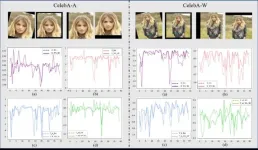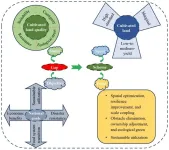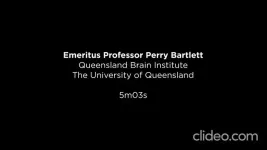(Press-News.org) Auroras have inspired myths and portents for millennia — but only now, with modern technology dependent on electricity, are we appreciating their true power. The same forces which cause auroras also cause currents that can damage infrastructure which conducts electricity, like pipelines. Now scientists writing in Frontiers in Astronomy and Space Sciences have demonstrated that the impact angle of interplanetary shocks is key to the currents’ strength, offering an opportunity to forecast dangerous shocks and shield critical infrastructure.
“Auroras and geomagnetically induced currents are caused by similar space weather drivers,” explained Dr Denny Oliveira of NASA’s Goddard Space Flight Center, lead author of the article. “The aurora is a visual warning that indicates that electric currents in space can generate these geomagnetically induced currents on the ground.”
“The auroral region can greatly expand during severe geomagnetic storms,” he added. “Usually, its southernmost boundary is around latitudes of 70 degrees, but during extreme events it can go down to 40 degrees or even further, which certainly occurred during the May 2024 storm — the most severe storm in the past two decades.”
Lights, color, action
Auroras are caused by two processes: either particles ejected from the sun reach Earth’s magnetic field and cause a geomagnetic storm, or interplanetary shocks compress Earth’s magnetic field. These shocks also generate geomagnetically induced currents, which can damage infrastructure that conducts electricity. More powerful interplanetary shocks mean more powerful currents and auroras — but frequent, less powerful shocks could also do damage.
“Arguably, the most intense deleterious effects on power infrastructure occurred in March 1989 following a severe geomagnetic storm — the Hydro-Quebec system in Canada was shut down for nearly nine hours, leaving millions of people with no electricity,” said Oliveira. “But weaker, more frequent events such as interplanetary shocks can pose threats to ground conductors over time. Our work shows that considerable geoelectric currents occur quite frequently after shocks, and they deserve attention.”
Shocks which hit the Earth head-on, rather than at an angle, are thought to induce stronger geomagnetically induced currents, because they compress the magnetic field more. The scientists investigated how geomagnetically induced currents are affected by shocks at different angles and times of day.
To do this, they took a database of interplanetary shocks and cross-referenced it with readings of geomagnetically induced currents from a natural gas pipeline in Mäntsälä, Finland, which is generally in the auroral region during active times. To calculate the properties of these shocks, such as angle and speed, they used interplanetary magnetic field and solar wind data. The shocks were divided into three groups: highly inclined shocks, moderately inclined shocks, and nearly frontal shocks.
Angle of attack
They found that more frontal shocks cause higher peaks in geomagnetically induced currents both immediately after the shock and during the following substorm. Particularly intense peaks took place around magnetic midnight, when the north pole would have been between the sun and Mäntsälä. Localized substorms at this time also cause striking auroral brightening.
“Moderate currents occur shortly after the perturbation impact when Mäntsälä is around dusk local time, whereas more intense currents occur around midnight local time,” said Oliveira.
Because the angles of these shocks can be predicted up to two hours before impact, this information could allow us to set in place protections for electricity grids and other vulnerable infrastructure before the strongest and most head-on shocks strike.
“One thing power infrastructure operators could do to safeguard their equipment is to manage a few specific electric circuits when a shock alert is issued,” suggested Oliveira. “This would prevent geomagnetically induced currents reducing the lifetime of the equipment.”
However, the scientists didn’t find strong correlations between the angle of a shock and the time it takes for it to hit and then induce a current. This may be because more recordings of currents at different latitudes are needed to investigate this aspect.
“Current data was collected only at a particular location, namely the Mäntsälä natural gas pipeline system,” cautioned Oliveira. “Although Mäntsälä is at a critical location, it does not provide a worldwide picture. In addition, the Mäntsälä data is missing several days in the period investigated, which forced us to discard many events in our shock database. It would be nice to have worldwide power companies make their data accessible to scientists for studies.”
END
Spectacular auroras are caused by head-on blows to Earth’s magnetic field that could damage critical infrastructure
Scientists find that interplanetary shocks which strike Earth’s magnetic field head-on cause more powerful ground-level electric currents, threatening pipelines and submarine cables
2024-07-10
ELSE PRESS RELEASES FROM THIS DATE:
An approach for robust facial attribute classification
2024-07-10
Face attribute classification (FAC) is a high-profile problem in biometric verification and face retrieval. Although recent research has been devoted to extracting more delicate image attribute features and exploiting the inter-attribute correlations, significant challenges still remain.
To solve the problems, a research team led by Na LIU published their new research on 15 June 2024 in Frontiers of Computer Science co-published by Higher Education Press and Springer Nature.
The team proposed a scattering-based hybrid block, termed WS-SE, to incorporate frequency-domain (WST) and image-domain (CNN) features in a channel attention manner. Compared with CNN, WS-SE achieved ...
Risky drinkers most at risk: Ads from sports broadcasts significantly increase alcohol urges
2024-07-10
10 July 2024
Risky drinkers most at risk: Ads from sports broadcasts significantly increase alcohol urges
New Edith Cowan University (ECU) research shows exposure to alcohol advertisements during national sports broadcasts, particularly those that feature a preferred beverage, significantly increases cravings in people with risky drinking behaviours.
The ECU study, led by Dr Ross Hollett, analysed nationally televised finals matches from the Australian Football League (AFL) and the National Rugby League (NRL) ...
How to differentially improve the cultivated land quality in China?
2024-07-10
Quality is the core characteristic of cultivated land and is crucial for ensuring sustainable resource utilization and national food security. To meet the increasing demand for food driven by rapid population growth and the continual optimization of dietary structures, the intensity of cultivated land utilization has been steadily increasing. This trend has resulted in degradation issues such as deterioration of black soil, thinning of the cultivated land layer, reduction in organic matter content, soil salinization, acidification, and contamination by heavy metals, all of which threaten national food security. Currently, China has entered a critical period of agricultural ...
Study reveals racial disparities in Huntington’s disease diagnoses
2024-07-10
New research led by UCLA Health revealed that Black patients with Huntington's disease in the U.S. and Canada received their diagnoses, on average, one year later compared to White patients after symptoms first appear.
Huntington’s disease is a rare, incurable genetic disease that causes a gradual death of nerve cells, resulting in a variety of symptoms affecting movement, emotions and cognition. About 41,000 Americans have the disease and 200,000 are at risk of inheriting it, according to the Huntington’s Disease Society of America. Children of a parent with ...
Archaeologists report earliest evidence for plant farming in east Africa
2024-07-10
A trove of ancient plant remains excavated in Kenya helps explain the history of plant farming in equatorial eastern Africa, a region long thought to be important for early farming but where scant evidence from actual physical crops has been previously uncovered.
In a new study published July 10 in the Proceedings of the Royal Society B, archaeologists from Washington University in St. Louis, the University of Pittsburgh and their colleagues report the largest and most extensively dated archaeobotanical record from interior east Africa.
Up until now, scientists have ...
UQ research reveals exercise brain boost can last for years
2024-07-10
A longitudinal study by University of Queensland researchers has found high-intensity interval exercise improves brain function in older adults for up to 5 years.
Emeritus Professor Perry Bartlett and Dr Daniel Blackmore from UQ’s Queensland Brain Institute led the study in which volunteers did physical exercise and had brain scans.
Emeritus Professor Perry Bartlett and Dr Daniel Blackmore have shown high intensity exercise boosts cognition in healthy older adults and the improvement was retained for up to 5 years.
Emeritus Professor Bartlett said it is the first ...
Researchers identify brain region involved in oxycodone relapse
2024-07-10
LA JOLLA, CA—Even years after they have recovered, a person who once struggled with alcohol or opioid addiction can relapse—and that relapse is more likely to occur during particularly stressful times. Now, Scripps Research scientists have identified an area of the brain that plays a key role in stress-induced oxycodone relapse. Their findings explain why the drug suvorexant, which they previously found to reduce alcohol and oxycodone relapse when administered orally, works so well.
“Having a better understanding of the region(s) in the brain responsible for this kind of relapse is incredibly important as we develop treatments for alcohol use disorder and opioid ...
Daily sugar intake fell by 5 g in kids + 11 g in adults year after UK sugar tax imposition
2024-07-10
Daily sugar intake fell by around 5 g in children and by around 11 g in adults in the 12 months following the introduction of the UK’s ‘sugar tax’, formally known as the Soft Drinks Industry Levy, finds an analysis of 11 years of survey data, published online in the Journal of Epidemiology & Community Health.
The sugar from soft drinks alone made up over half this total, the estimates suggest. But overall daily energy intake from free sugars levels are still higher than the updated recommendation from the World Health Organisation (WHO) of 5%---equivalent to 30 g/day for adults, 24 g for 7–10 year olds, and 19 g for 4–6 year olds—point ...
Osteoarthritis may double risk of speedy progression to severe multimorbidity
2024-07-10
Osteoarthritis—a condition in which the protective cartilage on the ends of bones breaks down—may more than double the risk of speedy progression to accumulating severe long term conditions (multimorbidity), finds a 20 year study published in the open access journal RMD Open.
And there seem to be 4 different speeds of progression to multimorbidity, the findings indicate.
Persistently low levels of physical activity, a high calorie diet, plus chronic low grade inflammation may help to explain the link between osteoarthritis and the risk of accumulating other long term conditions, suggest the researchers.
Although the exact causes aren’t known, injury, age, family ...
Researchers listen to the hearts of bats in flight
2024-07-10
Researchers from Konstanz have measured the heart rate of bats over several days in the wild, including complete flights—the first time this has been done for a bat species. To record the heart rate of male common noctule bats during flight, the scientists attached heart rate transmitters weighing less than one gram to the animals, which they then accompanied in an airplane while the bats flew, sometimes for more than an hour, in search of food. Their results, published in Proceedings of the Royal Society B, show how much energy bats consume over the course of a day and what energy-saving strategies they ...
LAST 30 PRESS RELEASES:
First Editorial of 2026: Resisting AI slop
Joint ground- and space-based observations reveal Saturn-mass rogue planet
Inheritable genetic variant offers protection against blood cancer risk and progression
Pigs settled Pacific islands alongside early human voyagers
A Coral reef’s daily pulse reshapes microbes in surrounding waters
EAST Tokamak experiments exceed plasma density limit, offering new approach to fusion ignition
Groundbreaking discovery reveals Africa’s oldest cremation pyre and complex ritual practices
First breathing ‘lung-on-chip’ developed using genetically identical cells
How people moved pigs across the Pacific
Interaction of climate change and human activity and its impact on plant diversity in Qinghai-Tibet plateau
From addressing uncertainty to national strategy: an interpretation of Professor Lim Siong Guan’s views
Clinical trials on AI language model use in digestive healthcare
Scientists improve robotic visual–inertial trajectory localization accuracy using cross-modal interaction and selection techniques
Correlation between cancer cachexia and immune-related adverse events in HCC
Human adipose tissue: a new source for functional organoids
Metro lines double as freight highways during off-peak hours, Beijing study shows
Biomedical functions and applications of nanomaterials in tumor diagnosis and treatment: perspectives from ophthalmic oncology
3D imaging unveils how passivation improves perovskite solar cell performance
Enriching framework Al sites in 8-membered rings of Cu-SSZ-39 zeolite to enhance low-temperature ammonia selective catalytic reduction performance
AI-powered RNA drug development: a new frontier in therapeutics
Decoupling the HOR enhancement on PtRu: Dynamically matching interfacial water to reaction coordinates
Sulfur isn’t poisonous when it synergistically acts with phosphine in olefins hydroformylation
URI researchers uncover molecular mechanisms behind speciation in corals
Chitin based carbon aerogel offers a cleaner way to store thermal energy
Tracing hidden sources of nitrate pollution in rapidly changing rural urban landscapes
Viruses on plastic pollution may quietly accelerate the spread of antibiotic resistance
Three UH Rainbow Babies & Children’s faculty elected to prestigious American Pediatric Society
Tunnel resilience models unveiled to aid post-earthquake recovery
Satellite communication systems: the future of 5G/6G connectivity
Space computing power networks: a new frontier for satellite technologies
[Press-News.org] Spectacular auroras are caused by head-on blows to Earth’s magnetic field that could damage critical infrastructureScientists find that interplanetary shocks which strike Earth’s magnetic field head-on cause more powerful ground-level electric currents, threatening pipelines and submarine cables




